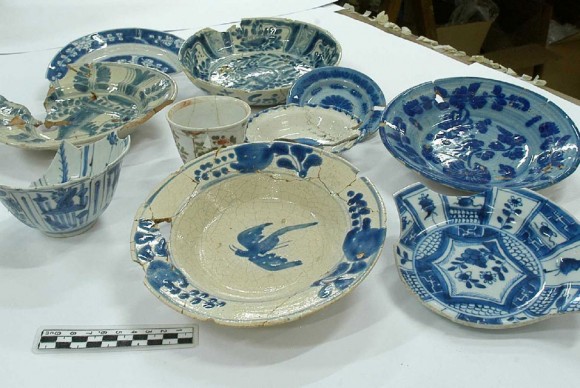More Findings Registered Under Palacio de Bellas Artes
MEXICO CITY.- Nearly 50 pieces that include Prehispanic ritual objects and Colonial vessels, among them, porcelains from the Ming and Qing dynasties, as well as a dozen human burials, are part of the findings registered under Palacio de Bellas Artes during excavations conducted by the Archaeological Salvage Direction of the National Institute of Anthropology and History (INAH).
Information was announced by researcher Miguel Hernandez Perez, coordinator of the archaeological project when accounting for the objects discovered throughout the year at the underground excavations that will be finished in the third week of July 2010, and that took place at the same time as hydraulic system of Palacio de Bellas Artes underwent modification.
The archaeologist indicated that human skeletons and other findings add up to architectural elements detected in 2009; discoveries date from Prehispanic age up to late 19th and early 20th centuries. Vestiges of the Convent of the Visitation of Holy Mary placed there in the 17th century stand out.
Hernandez Perez mentioned that the site where Palacio de Bellas Artes stands currently was occupied by a small Mexica settlement part of Moyotlan neighborhood: there were channels that formed part of a complex hydraulic system used by Tenochtitlan people to gain space to the lake and create chinampas to grow different products.
A great amount of vessels, figurines, seals, censers, tripod pots, pots, jars, flat bowls, an obsidian labret, whistles, a fragment of a brazier and other pieces part of agricultural rites offerings were recovered. Most ceramic material corresponds to types Aztecs II and II, as well as to Texcoco Red, from the last stage of Prehispanic period.
Colonial findings correspond to the vestiges of a 17th century convent. “We found 4 patios with rests of columns, and vestiges of walls with paintings”.
The archaeologist declared that near Eje Central Avenue, 10 Colonial entombments were located; 8 of them were covered with lime, indicating they died during an epidemic.
“When the convent was divided, the temple kept working for a few years. At that time wealthy families used to bury their members in the temple or the atrium.
“Skeletons correspond to adults and children, and some of them wore crucifixes and rosary’s beads”, mentioned Hernandez, adding that physical anthropologist Miguel Silva Magaña will be in charge of the rests´ studies, which will reveal aspects such as the sex of the individuals, their ages, and information like diseases and possible causes of death.
Regarding ceramic material found, archaeologist Miguel Hernandez recalled that nearly 50 complete Colonial pieces, among dishes, cups, spoons and chamber pots were recovered. “Some dishes have written the name of the nun who used them; there are also porcelain brought from China, of the Ming and Qing, maiolica from Puebla and domestic tools like jars and casseroles”.
Patricia Garcia Navarro, specialist on archaeozoology and archaeobotanics carries on the study of bones found to determine the used given to the animals, although most of them were destined to be consumed or as company; “they are mainly cows, horses, hens, dogs, cats, sheep, goats and deer rests”.
Hernandez Perez detailed that movable material found is being analyzed and registered by archaeologists Juan Carlos Campos, Monserrat Alavez, Felix Rios Soriano and Alejandro Isaac Romero.
Mural painting and architectonic rests were protected and covered again after a meticulous photographic register that will help knowing more about historical and cultural modifications of the plot.
Related posts:
- Colonial Painting Found in Palacio de Bellas Artes Restored
- Subway System Excavations Important for Archaeology
- Las Artes de México on View at the Utah Museum of Fine Arts
- Tate’s Ben Borthwick Appointed CEO and Artistic Director of Artes Mundi
- Baja California Cultural Heritage Suffered No Earthquake Damage

